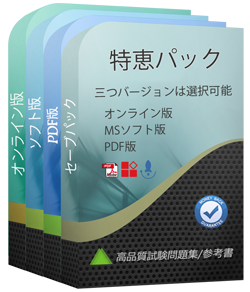返金するポリシーはありますか? 失敗した場合、どうすれば返金できますか?
はい。弊社はあなたが我々の練習問題を使用して試験に合格しないと全額返金を保証します。返金プロセスは非常に簡単です:購入日から60日以内に不合格成績書を弊社に送っていいです。弊社は成績書を確認した後で、返金を行います。お金は7日以内に支払い口座に戻ります。
更新されたBPS-Pharmacotherapy試験参考書を得ることができ、取得方法?
はい、購入後に1年間の無料アップデートを享受できます。更新があれば、私たちのシステムは更新されたBPS-Pharmacotherapy試験参考書をあなたのメールボックスに自動的に送ります。
購入後、どれくらいBPS-Pharmacotherapy試験参考書を入手できますか?
あなたは5-10分以内にBPS BPS-Pharmacotherapy試験参考書を付くメールを受信します。そして即時ダウンロードして勉強します。購入後にBPS-Pharmacotherapy試験参考書を入手しないなら、すぐにメールでお問い合わせください。
あなたはBPS-Pharmacotherapy試験参考書の更新をどのぐらいでリリースしていますか?
すべての試験参考書は常に更新されますが、固定日付には更新されません。弊社の専門チームは、試験のアップデートに十分の注意を払い、彼らは常にそれに応じてBPS-Pharmacotherapy試験内容をアップグレードします。
あなたのテストエンジンはどのように実行しますか?
あなたのPCにダウンロードしてインストールすると、BPS BPS-Pharmacotherapyテスト問題を練習し、'練習試験'と '仮想試験'2つの異なるオプションを使用してあなたの質問と回答を確認することができます。
仮想試験 - 時間制限付きに試験問題で自分自身をテストします。
練習試験 - 試験問題を1つ1つレビューし、正解をビューします。
Tech4Examはどんな試験参考書を提供していますか?
テストエンジン:BPS-Pharmacotherapy試験試験エンジンは、あなた自身のデバイスにダウンロードして運行できます。インタラクティブでシミュレートされた環境でテストを行います。
PDF(テストエンジンのコピー):内容はテストエンジンと同じで、印刷をサポートしています。
BPS-Pharmacotherapyテストエンジンはどのシステムに適用しますか?
オンラインテストエンジンは、WEBブラウザをベースとしたソフトウェアなので、Windows / Mac / Android / iOSなどをサポートできます。どんな電設備でも使用でき、自己ペースで練習できます。オンラインテストエンジンはオフラインの練習をサポートしていますが、前提条件は初めてインターネットで実行することです。
ソフトテストエンジンは、Java環境で運行するWindowsシステムに適用して、複数のコンピュータにインストールすることができます。
PDF版は、Adobe ReaderやFoxit Reader、Google Docsなどの読書ツールに読むことができます。
割引はありますか?
我々社は顧客にいくつかの割引を提供します。 特恵には制限はありません。 弊社のサイトで定期的にチェックしてクーポンを入手することができます。
BPS Pharmacotherapy (Part1 and Part2) 認定 BPS-Pharmacotherapy 試験問題:
1. An 18-year-old patient presents with abrasions on the hands, knees, and shoulder from a recent bicycle accident. Gram-staining of surgical incision and drainage specimens reveals Gram positive cocci in chains. The patient has necrotizing fasciitis and develops bronchospasms after being given penicillin. Which intravenous antibiotic would be best to use in place of penicillin?
A) Clindamycin
B) Sulfamethoxazole/trimethoprim
C) Ceftriaxone
D) Ciprofloxacin
2. A 46-year-old patient begins treatment with allopurinol 300 mg daily following the onset of an acute gout attack due to elevated uric acid.
The patient's other medications are:
* Cyclosporine 800 mg daily
* Prednisone 20 mg daily
* Azathioprine 100 mg daily
* Nifedipine extended release 90 mg daily
Several days later there was an observed decrease in the patient's WBC count. Which drug interaction with allopurinol is most likely to account for this change?
A) Cyclosporine
B) Prednisone
C) Azathioprine
D) Nifedipine
3. After 9 days of hospitalization, a 60-year-old 60-kg patient has a temperature of 39.4°C and a WBC count of 20,000 cells/uL. A sputum sample shows numerous WBCs and Gram-negative bacilli. The serum creatinine is 1.0 mg/dL. For this patient, which of the following drugs would be most appropriate for initial parenteral therapy?
A) Cefepime, levofloxacin, and vancomycin
B) Tobramycin and cefepime
C) Ceftriaxone and azithromycin
D) Aztreonam, clindamycin, and vancomycin
4. A 25-year-old woman who is HIV-positive and has a CD4+ count of 120 cells/mm begins antiretroviral therapy. The patient's CD4+ count drops to 45 cells/mm3 over the next year. For which of the following opportunistic infections should this patient receive prophylaxis?
A) MAC and Candida
B) Mycobacterium tuberculosis and CMV
C) Mycobacterium tuberculosis and Pneumocystis Jirovecii pneumonia
D) MAC and Pneumocystis jirovecii pneumonia
5. A patient with a COPD exacerbation is treated with prednisone 40 mg daily for one week with improvement. To discontinue the prednisone, the most appropriate procedure would be which of the following?
A) Reducing the daily prednisone dose by 50% every day until the patient is off the drug.
B) Stopping prednisone administration without dose tapering.
C) Reducing the daily prednisone dose by 50% every other day until it is down to 10 mg daily, then reducing it by 25% every other day until the patient is off the drug.
D) Reducing the daily prednisone dose by 25% every day until the patient is off the drug.
質問と回答:
| 質問 # 1 正解: A | 質問 # 2 正解: A | 質問 # 3 正解: B | 質問 # 4 正解: D | 質問 # 5 正解: B |


 弊社は製品に自信を持っており、面倒な製品を提供していません。
弊社は製品に自信を持っており、面倒な製品を提供していません。



 -Asakawa
-Asakawa

